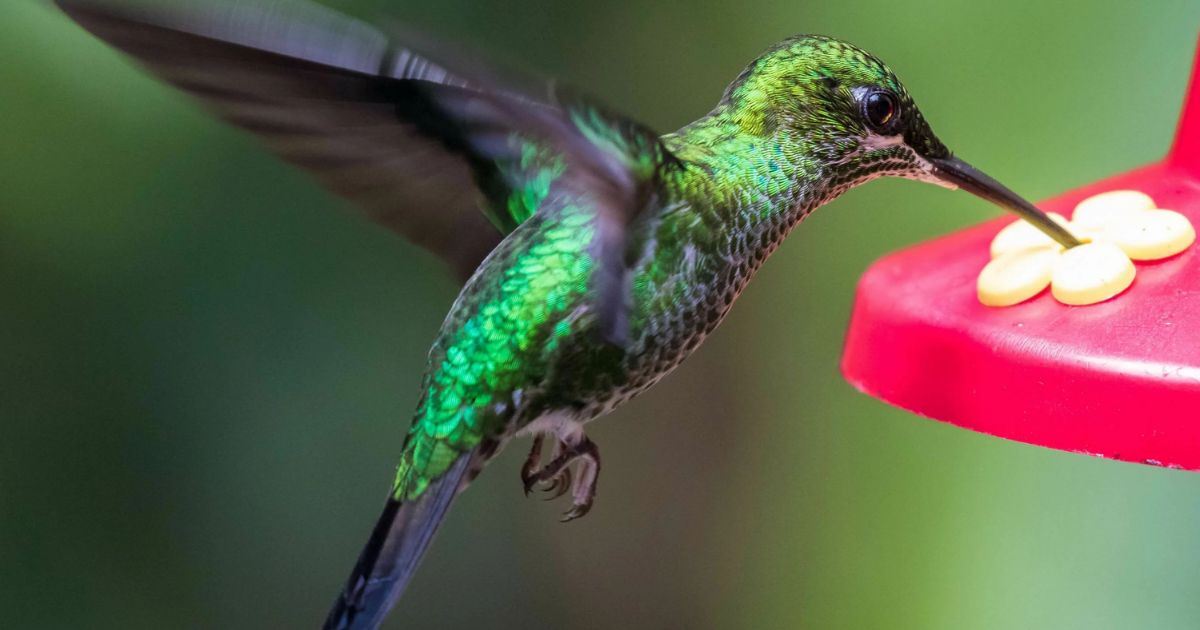Attracting hummingbirds to your backyard is easy with a simple homemade nectar recipe.
Here’s the key takeaway:
- Mix 1 part sugar with 4 parts water: This is the safe and effective ratio for hummingbird food. Avoid red dye, artificial sweeteners, or honey, as they can harm the birds.
- Keep it clean and fresh: Change and clean your feeders regularly to prevent mold growth. Leftover nectar can be stored in the fridge for a week, but always use fresh nectar in your feeders.
- Enjoy the vibrant visitors: With a reliable nectar source, you’ll soon be witnessing the dazzling display of hummingbirds as they flit and feed in your garden.
How to Make Hummingbird Nectar
At the heart of attracting hummingbirds lies a sweet, sugar-infused nectar solution – their favorite liquid treat. This energy-packed elixir not only provides them with the fuel they need but also serves as an irresistible lure, drawing them to your yard time and time again. Crafting the perfect nectar is easier than you might think!
Creating a homemade hummingbird nectar is a simple process that requires just two ingredients: white granulated sugar and water. The key lies in getting the ratio just right to mimic the natural nectar found in flowers. Too little sugar, and the nectar won’t provide enough energy; too much, and it can be harmful to the hummingbirds’ delicate systems.
The ideal sugar-to-water ratio for hummingbird nectar is 1 part sugar to 4 parts water. For example, if you’re using 1 cup of sugar, you’ll need 4 cups of water. This balanced blend ensures that the nectar is sweet enough to attract hummingbirds while also being easily digestible for their tiny bodies.
Here’s a step-by-step guide on how to make hummingbird nectar:
- Combine the sugar and water: In a saucepan, mix the sugar and water according to the 1:4 ratio.
- Bring to a gentle boil: Place the saucepan on the stove and bring the mixture to a gentle boil, stirring occasionally to help the sugar dissolve completely.
- Remove from heat and cool: Once the sugar has fully dissolved, remove the saucepan from the heat and allow the nectar to cool completely.
- Transfer to a storage container: Pour the cooled nectar into an airtight container or bottle for storage in the refrigerator.
“The key to success is simplicity itself.” – Bruce Lee
Simplicity is indeed the key when it comes to making hummingbird nectar. No need for fancy ingredients or complicated processes – just sugar, water, and a bit of patience. Remember, never add any additional ingredients like honey, food coloring, or artificial sweeteners, as these can be harmful to hummingbirds.
Related Post: What is the Pizza Edition?
Homemade Hummingbird Food Tips
While the recipe itself is straightforward, there are a few tips and tricks to ensure your homemade hummingbird food is a hit with your feathered friends:
- Use pure white sugar: Avoid using honey, artificial sweeteners, or brown sugar, as these can be detrimental to hummingbirds’ health.
- Boil the mixture: Boiling helps dissolve the sugar completely and reduces the risk of fermentation or mold growth in your nectar.
- Allow it to cool completely: Never add hot nectar to your feeders, as it can cause burns or other injuries to the delicate hummingbirds.
- Refrigerate leftovers: Store any unused nectar in the refrigerator for up to one week to maintain freshness.
- Clean feeders regularly: Disassemble and thoroughly clean your hummingbird feeders every few days to prevent the growth of mold or bacteria.
- Change nectar frequently: Replace the nectar in your feeders every 3-5 days, especially during hot weather, to prevent fermentation and ensure a constant supply of fresh nectar for your winged visitors.
Following these simple tips will not only ensure that your homemade hummingbird food is safe and appealing but also help you maintain a clean and welcoming environment for these tiny pollinators.
Hummingbird Food Feeders
Now that you’ve mastered the art of creating the perfect hummingbird nectar, it’s time to choose the ideal feeder to showcase your sweet creation. Hummingbird feeders come in a wide variety of styles, from simple to elaborate designs, each with its own unique features.
When selecting a hummingbird feeder, consider the following factors:
- Bright colors: Hummingbirds are naturally drawn to bright, vibrant colors, especially red – the color of many nectar-producing flowers. Feeders with red accents or components tend to be more attractive to these tiny birds.
- Bee guards: While bees are essential pollinators, they can quickly drain your hummingbird feeders of nectar. Look for feeders with built-in bee guards or opt for styles with narrow feeding ports that discourage bee access.
- Easy-to-clean components: Maintaining a clean feeder is crucial for the health and safety of your hummingbird visitors. Choose feeders with removable and easily accessible components that can be thoroughly scrubbed and rinsed.
- Perching options: Hummingbirds love to rest and survey their surroundings, so feeders with built-in perches or perching rings can make your backyard even more inviting for these tiny aviators.
With so many styles and designs available, finding the perfect hummingbird feeder to complement your outdoor space and attract these winged jewels is easier than ever.
How do you attract hummingbirds to your yard?
Creating a hummingbird-friendly environment is key to luring these tiny aviators to your outdoor oasis. While a well-stocked feeder is a surefire way to grab their attention, there are several other tactics you can employ to make your yard even more appealing:
- Plant nectar-rich flowers: Embrace a garden filled with vibrant blooms like fuchsias, petunias, honeysuckle, and other tubular flowers that are rich in nectar – a hummingbird’s natural food source.
- Provide perches: Hummingbirds love to rest and survey their surroundings, so offer them convenient perching spots near your feeders or flowering plants.
- Add a water source: A shallow birdbath or misting system can provide refreshment and bathing opportunities on hot summer days.
- Hang your feeders strategically: Position your hummingbird feeders near flowering plants or trees, but away from areas with heavy foot traffic or potential predators.
- Be patient: It may take some time for hummingbirds to discover your new backyard oasis, but once they do, they’ll likely become regular visitors if you maintain a consistent supply of fresh nectar and a welcoming environment.
By combining a well-stocked feeder with a blooming garden and other hummingbird-friendly features, you’ll create an irresistible haven that’s sure to attract these fascinating feathered friends in no time.
Hummingbird Food and Nectar Recipe
Alright, it’s time to reveal the star of the show – the hummingbird food and nectar recipe that will have these tiny tweeters flocking to your yard!
Equipment
- Saucepan
- Spoon or whisk
- Airtight container or bottle for storage
Ingredients
- 1 part white granulated sugar
- 4 parts water
Instructions
How to Make Hummingbird Nectar:
- In a saucepan, combine the sugar and water according to the 1:4 ratio (e.g., 1 cup sugar and 4 cups water).
- Bring the mixture to a gentle boil, stirring occasionally until the sugar has fully dissolved.
- Remove from heat and allow the nectar to cool completely.
- Once cooled, transfer the nectar to an airtight container or bottle for storage in the refrigerator.
- Before filling your hummingbird feeders, thoroughly clean and rinse them to remove any residue or debris.
- Fill the feeders with the freshly prepared nectar, being careful not to overfill or spill.
- Hang or place the feeders in a shaded area, preferably near flowering plants or trees.
- Monitor the feeders regularly, refilling or replacing the nectar as needed to ensure a constant supply for your winged visitors.
Notes
- Adjust quantities as needed: The recipe can be easily scaled up or down to suit your feeder size and the number of hummingbirds visiting your yard.
- Avoid additives: Stick to just sugar and water – no food coloring, honey, or other additives.
- Clean feeders regularly: Disassemble and thoroughly clean feeders every few days to prevent the growth of mold or bacteria.
- Change nectar frequently: Replace the nectar every 3-5 days, especially during hot weather, to maintain freshness and prevent fermentation.
With this simple yet irresistible hummingbird food and nectar recipe, you’ll have a constant stream of these tiny, jewel-toned visitors gracing your yard. Sit back, relax, and enjoy the mesmerizing sight of hummingbirds darting from feeder to flower, fueled by your homemade nectar.
More Non-Alcoholic Drink Recipes
Looking for more delightful non-alcoholic drink recipes? Check out our collection of refreshing beverages, perfect for quenching your thirst:
Stay hydrated and enjoy the flavors of summer with these tasty and rejuvenating beverage options.
FAQs About Hummingbird Food and Nectar
While the process of making hummingbird nectar is simple, you may still have some lingering questions. Here are some frequently asked questions and their answers:
Q: Can I use honey instead of sugar in my hummingbird nectar? A: No, it’s best to avoid using honey in your hummingbird nectar recipe. Honey can ferment quickly, leading to potential health issues for the hummingbirds. Stick to plain white granulated sugar for the safest and most effective nectar solution.
Q: How often should I change the nectar in my hummingbird feeders? A: It’s recommended to replace the nectar every 3-5 days, or more frequently during hot weather. Fresh nectar ensures that your feathered friends have a constant supply of high-quality food and helps prevent the growth of mold or bacteria.
Q: Can I use artificial sweeteners or brown sugar for my hummingbird nectar? A: No, it’s best to avoid using artificial sweeteners or brown sugar in your hummingbird nectar recipe. These substitutes can be harmful to hummingbirds and may not provide the necessary energy they need. Stick to plain white granulated sugar for the safest and most effective nectar solution.
Q: Do I need to boil the nectar mixture? A: Yes, it’s recommended to bring the sugar and water mixture to a gentle boil before cooling it. Boiling helps dissolve the sugar completely and reduces the risk of fermentation or mold growth in your nectar.
Q: Can I add food coloring to my hummingbird nectar? A: While adding food coloring might seem like a fun way to make your nectar more visually appealing, it’s best to avoid adding any artificial colors or additives. These can potentially be harmful to hummingbirds and may deter them from consuming the nectar.
Final Words
Creating homemade hummingbird nectar with the correct sugar-to-water ratio ensures a nutritious and safe food source for these tiny birds. Regularly changing the nectar and keeping feeders clean is crucial for their health. Avoiding honey or artificial sweeteners is essential to prevent harm.
Also, fostering a hummingbird-friendly environment with abundant flowers and clean water sources will attract and support these fascinating creatures, contributing to their well-being and enjoyment in your garden.

